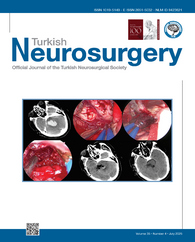2Shanghai Punan Hospital, Department of B-ultrasound Room of Physical Examination, Shanghai, China
3Shanghai Punan Hospital, Department of Nurse, Shanghai, China
4Shanghai Punan Hospital GICU, Shanghai, China DOI : 10.5137/1019-5149.JTN.47938-24.3 AIM: To explore the risk factors associated with the occurrence of lower extremity deep vein thrombosis (DVT) after craniotomy in patients with primary brain tumors, and to develop a predictive model using machine learning.
MATERIAL and METHODS: A prospective cohort study was conducted on 140 patients with primary brain tumors who underwent neurosurgical treatment at our hospital between March 2021 and September 2022. A logistic regression analysis was performed to identify independent risk factors associated with postoperative DVT. Additionally, multiple machine learning models were developed and evaluated to determine their predictive performance.
RESULTS: The incidence of lower extremity DVT after craniotomy was 27.9%. Logistic regression identified age [OR=1.07, 95% CI (1.03-1.11)], GCS score [OR=0.88, 95% CI (0.78-0.98)], D-dimer level [OR=1.08, 95% CI (1.02-1.15)], and mechanical ventilation (≥48 hours) [OR=3.83, 95% CI (1.21-12.15)] as independent risk factors (P<0.05). The Gradient Boosting Machine (GBM) had the highest prediction accuracy among the assessed machine learning models, achieving an area under the curve (AUC) of 0.850, with a sensitivity of 56.44% and a specificity of 90.09%.
CONCLUSION: Age, D-dimer, and mechanical ventilation (≥48 hours) are independent risk factors for the development of lower extremity DVT after craniotomy in patients with primary brain tumors. The GCS score serves as a potential protective risk factor. The GBM model, with its high AUC and specificity, offers a promising tool for early identification of high-risk patients, potentially informing clinical decision-making and targeted interventions.
Keywords : Brain tumor, Lower extremity, Machine learning, Venous thrombosis




